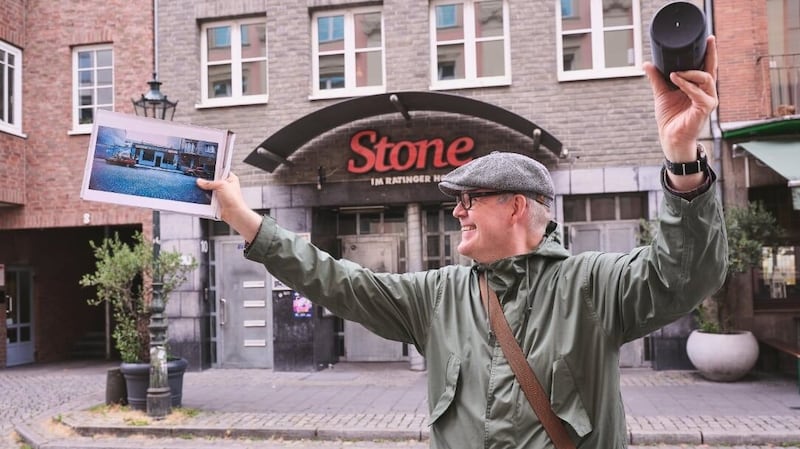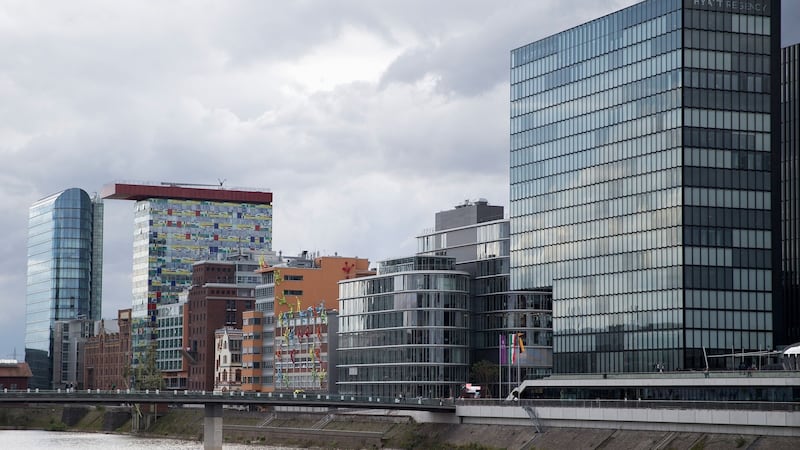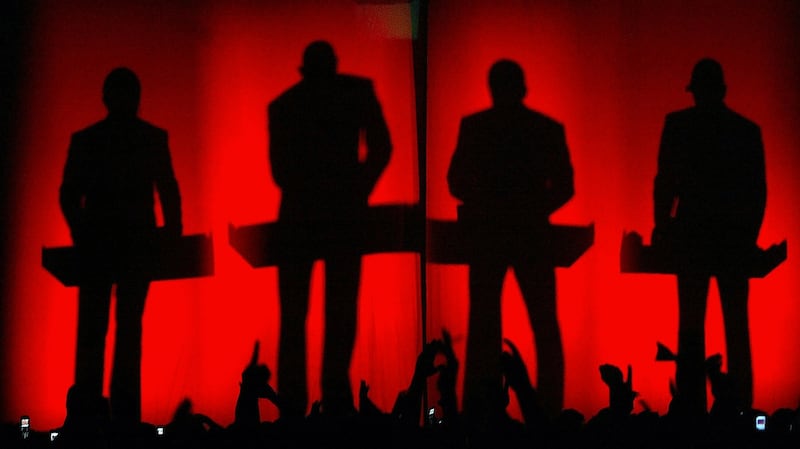Fifty years ago, in 1970, Kraftwerk, led by Ralf Hütter and Florian Schneider, formed in the German Rhineland city of Düsseldorf. Their first three albums were progressive jazz-inflected rock. But with their fourth LP, Autobahn, Kraftwerk's music became almost wholly electronic, made on synthesisers, drum pads and sequencers in their small Düsseldorf studio.
The five albums they released between 1974 and 1981 – Autobahn, Radio-Activity, Trans-Europe Express, The Man-Machine and Computer World – were pioneering, and deeply influential on 80s synthpop, early hip-hop, and 90s techno. Their melodies and musical textures still pervade pop music. They posed as robots two decades before Daft Punk did, and explored European freedom of movement 40 years before the UK rejected it. Where once they seemed futuristic, now they seem contemporary.
Now, with the publication of a new book about the group, Uwe Schütte's Kraftwerk: Future Music From Germany, it seems like the right time to reassess their legacy. I wanted to find out more about the humans behind the robots, so I travelled to Kraftwerk's home city of Düsseldorf to investigate.
Kraftwerk's music isn't just a West German soundtrack, but a recognisably European one, and its influence stretches far beyond those boundaries
Kraftwerk’s studio, Kling Klang, was based for almost 40 years in a small room next to a courtyard off a moderately sleazy street near Düsseldorf’s central station. A couple of weeks ago I went there, walking through the gateway above which a sign reads “Elektro Müller GmbH” – the name of a company that was based on the first floor of the building – and climbing some steps whose significance is marked by a traffic cone, a symbol used on the cover of Kraftwerk’s earliest, pre-Autobahn records.
The room is still used as a recording studio, although it’s much changed from the Kraftwerk era – only a basic wall-mounted phone, from which the band removed the bell to discourage interruptions, remains. (They moved out in 2009.) You walk through a door into a small hall, then turn left, entering the main room, into which some natural light spills through opaque glass bricks that face out to the courtyard. The studio is rectangular, perhaps 20ft by 30ft in size, just large enough to allow Kraftwerk to experiment with their banks of electronic equipment and to record their albums.
The current owner tells me that that it was intimidating at first when he moved in, but that he had to change the space to suit his needs, and that he only tells musicians who are recording there about its past if he’s sure they won’t freak out. Occasionally, he says, fans press their hands up against the glass bricks, pilgrims communing with the building’s musical past.
The musical pilgrimage is increasingly becoming a way for cities to brand themselves, to attract cultural tourists interested in the history of pop music to industrial or post-industrial metropolises they might otherwise have neglected. Düsseldorf's musical heritage is sizeable: artists such as Neu!, Die Toten Hosen, La Düsseldorf, Die Krupps, Propaganda, D.A.F., Mouse on Mars, and latterly the post-rock band Kreidler, have emerged from the city. But the city's own Fab Four, Kraftwerk, remain the most internationally recognisable.
For Thorsten Schaar of Düsseldorf's tourist office, the city's potential for musical tourism was revealed by the intense international interest in Kraftwerk's performance at the Tour de France's Grand Départ, which took place in Düsseldorf in July 2017. Before taking up his current job, Schaar had been a local journalist who contributed to magazines and wrote for Die Toten Hosen's website. He's a big music fan: when I meet him he's just returned from Amsterdam, where he saw Liam Gallagher and Supergrass gigs. He tells me that he's keen for any celebration of the city's musical heritage to speak to the present and the future of the local scenes, to not just look backwards but to look forward too.

At the gateway outside Kling Klang, I meet Michael Wentzel – who introduces himself as "Michael from Düsseldorf" – and Sven-André Dreyer, two local writers who run "The Sound of Düsseldorf", an enthusiastic and entertaining weekly musical walking tour of the city. A short taxi ride across the compact city centre brings us to a sleek chrome-clad skyscraper, the Dreischeibenhaus, completed in 1960 that physically represents the Wirtschaftswunder – the economic "wonder" of postwar reconstruction in the Rhineland.
The aerial bombing of Düsseldorf by Allied forces during the second World War destroyed 90 per cent of the city’s buildings. Its rapid reconstruction included futuristic additions, such as the Dreischeibenhaus and an office block in the International style built on the banks of the Rhine, designed by Paul Schneider-Esleben, the father of Kraftwerk member Florian Schneider.
Düsseldorf is at the centre of Europe
Schütte’s book in part examines the band’s work in the context of their emergence in postwar Germany, and specifically Düsseldorf. All four of the band’s classic line-up – Hütter, Schneider, Wolfgang Flür and Karl Bartos – were born after the war, and their outlook, oriented towards the future, mirrored the forward-facing trajectory of West Germany. Their enthusiasm for travel and their embrace of a wider European identity – evidenced especially on the album Trans-Europe Express – made them representative of a country that was keen to refashion itself after the horrors of the war. But, as Schütte points out, the material infrastructure that Kraftwerk documented in their songs – the autobahn, the railways – were deeply ambivalent symbols that retained the memory of Nazism (the autobahn system being a pet project of Adolf Hitler, the railways playing a key part in the Holocaust).
Nevertheless, Kraftwerk, so rooted in Düsseldorf, whose aim was to record a sort of regional industrial electronic music – what David Bowie called "the folk music of the factories" – by distilling the essence of a place and a time, then pushing it towards abstraction, created music that was simultaneously specific and universal. Kraftwerk's music isn't just a West German soundtrack, but a recognisably European one, and its influence stretches far beyond those boundaries.

Visiting Düsseldorf brings this home to me. It’s a very pleasant city in which to spend a couple of days mooching around its brewery pubs drinking glasses of brown altbier, strolling through the old town’s cobbled streets and squares, and taking in its architecture both classic and modern. But it’s also a highly networked, deeply infrastructurally connected microcosm of postwar West Germany, and of what Europe would soon become. A future city, destroyed then rebuilt, with elements of the past dotted amongst the modern, mostly looking ahead with the odd glance backwards. It’s as if Kraftwerk’s economically accelerating home town allowed them to glimpse the modernity that would extend across the continent, everywhere familiar but different; variations on a theme.
"Düsseldorf is at the centre of Europe", says Ralf Dörper, former member of the synthpop band Propaganda and founding member of the post-punk-turned-techno-metal band Die Krupps. He's telling me about how easy it is to get to other European cities by train via Düsseldorf's Hauptbahnhof, or by plane from its convenient airport. But geographically his statement is also more or less true, and culturally it might work as well: Kraftwerk made the city central to European music. (Rudi Esch, another former member of Die Krupps, wrote an oral history of the music scene, Electri_City: Electronic Music from Düsseldorf.)
Düsseldorf was, and is, an affluent city in a largely industrial region. Both Schneider and Hütter were from wealthy families and without that affluence it seems unlikely that Kraftwerk could have afforded the technology with which they produced their music. Dörper tells me that the early electronica of Die Krupps was influenced more by the English industrial band Throbbing Gristle than Kraftwerk, partially because they couldn’t afford the cutting-edge instruments that Kraftwerk used.
In Düsseldorf, when they weren’t working, Kraftwerk often visited the city’s high-end disco clubs, where wealthy businessmen went to meet models, who had come to the city to work in its fashion industry. (Kraftwerk’s 1982 UK number 1 The Model is drawn from life.) It’s clear that the rhythmic, funky music they heard in these clubs worked its way into their own records, an influence that was picked up by early American hip-hop. Afrika Bambaataa’s 1982 record Planet Rock used elements of Kraftwerk’s tracks Trans-Europe Express and Numbers without permission from the band. Eventually an agreement was reached whereby the Düsseldorf group received a dollar for each copy of the half a million singles sold by Bambaataa.
Kraftwerk emerged from the collective, experimental and loosely improvisational culture of what was christened Krautrock – exemplified by the Cologne band Can, and Düsseldorf's Neu!, whose members Klaus Dinger and Michael Rother had been in an earlier line-up of Kraftwerk. With Kraftwerk, acoustic instruments gave way, beginning with 1974's Autobahn LP (on which the only traditional instrument was a flute played bySchneider) to a purely electronic music that drew inspiration from the motion of everyday life – recreating the rhythm of a train, or the experience of a car journey, or the physical sense of cycling.

The idea of electronic music being produced by a harmonious combination of machine and worker transferred an idealised concept of the factories that surround Düsseldorf to the recording studio. (Kraftwerk is German for power-plant.) Schütte’s book suggests that Kraftwerk should be considered conceptual artists producing a total artwork (there’s a German compound word for this: Gesamtkunstwerk) of which music is one aspect, and that their evolution into a cutting-edge contemporary touring act playing surround-sound live shows that feature high-tech 3D animations is the ultimate realisation of the group’s artistic potential.
As our walking tour continues through the city, the relationship between music and art becomes clear. We stand outside what was the Creamcheese club, around the corner from the art galleries and only a couple of streets from the city's art school. Wentzel and Dreyer play Frank Zappa's Son of Suzy Creamcheese on the Bluetooth speaker they carry with them on the tour, showing us a poster of a gig Kraftwerk, with an early line-up that didn't include Hütter, played in the venue in 1970. The Creamcheese, an art gallery-cum-nightclub that operated between 1967 and 1976, was inspired by Andy Warhol's multimedia happenings and designed and run by artists. It became a meeting point for local artists and musicians. Inside, multiple TV screens running 24 hours a day displayed footage from the club's "action space" – the live room where gigs and artistic events took place – or showed video art, while progressive rock played on the sound system.
We reach the former site of the Ratinger Hof, a key punk venue that played host to local bands D.A.F. and Die Toten Hosen as well as touring British punk and post-punk acts such as Wire and Dexy’s Midnight Runners. Many Düsseldorf musicians and music fans would have heard these bands on John Peel’s show on British Forces Broadcasting Service, and his influence continued into the 80s and beyond. It seems remarkable that Peel, who played a key role in publicising underground music in the UK, should have acted as a key link between that music and youth culture in the Rhineland.
Our musical tour, aside from guiding us through the city’s pop cultural past, pays a visit to the present scene, at the Salon des Amateurs, a nightclub and cafe that operates from a corner of the brutalist Kunsthalle art gallery, attracting local acts and touring DJs who play eclectic sets that often continue until 8am the next morning. Kraftwerk may have left the city – Hütter, the remaining member from their classic era, runs the group’s affairs from a business park in a small town a few miles away – but the electronic heartbeat of Düsseldorf continues to pulse.
Kraftwerk: Future Music From Germany is published by Penguin











